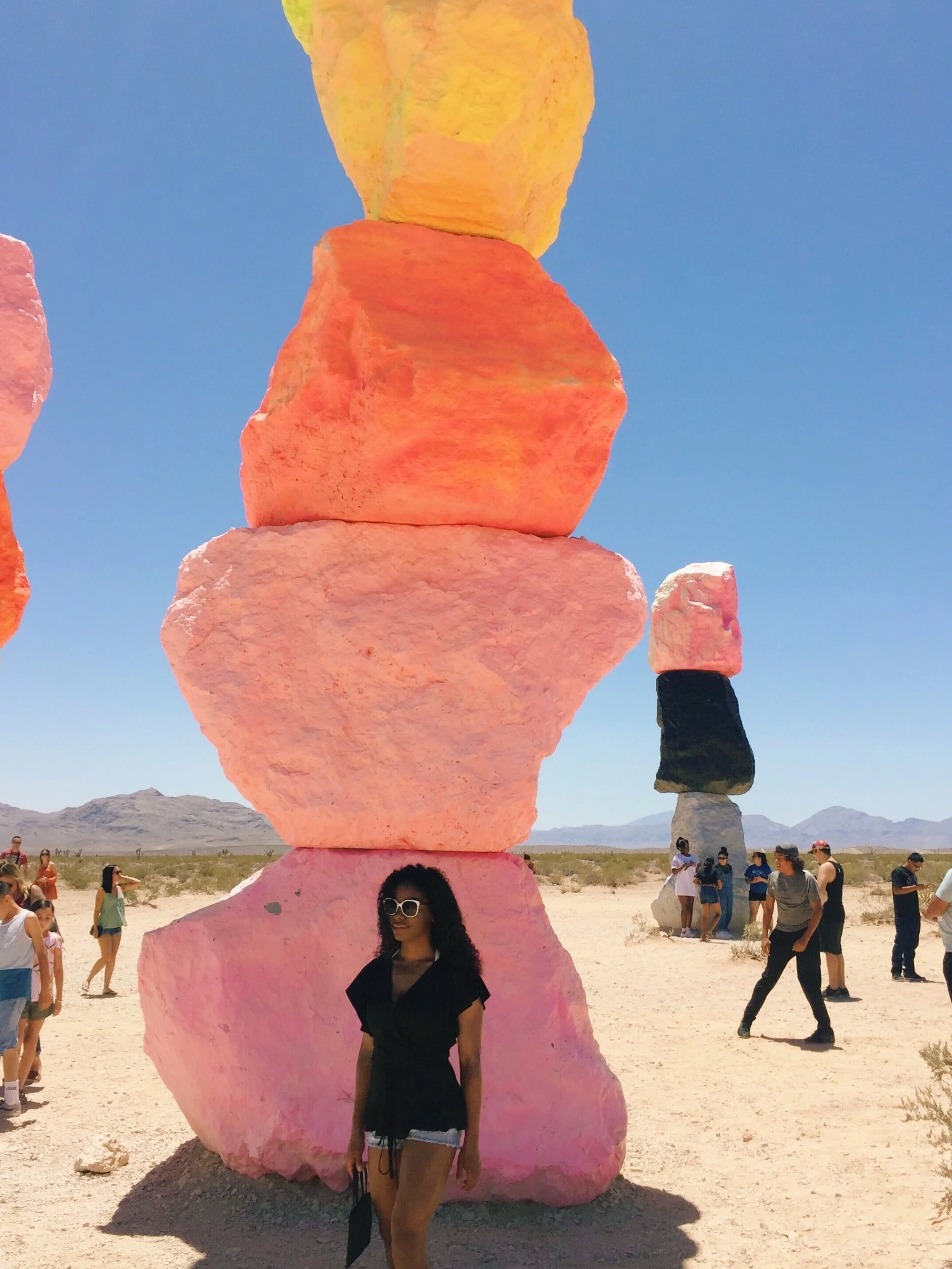Must-see Land Art: Seven Magic Mountains
While in Las Vegas, I visited Seven Magic Mountains, a large-scale, site-specific public artwork by Swiss artist Ugo Rondinone. It consists of seven giant monoliths made of stacked boulders that are seemingly perfectly balanced on top of one another. Each of these mountains is painted a different combination of highly-saturated, bold colors. It is located about 25- minutes drive outside of downtown Las Vegas, in the middle of the desert, right off of the highway.
Rondinone installed this work in May 2016, with the intention of a two-year exhibition. However, its popularity has encouraged a longer stay in its current location, with a guarantee that the work will remain there at least until the end of 2018. There are currently plans being produced to make this a multiple-year or possibly permanent installation.
Does this art have any greater meaning, beyond an aesthetic landmark meant to attract tourists? I'm here to break that down. And while I won't be imposing a final verdict (everyone's perspective will be different yet equally valid, and art has no right or wrong answers), I've done some research and will provide some context that can help demystify this huge conceptual work.
Ugo Rondinone
As mentioned, Rondinone is a Swiss artist, who moved to New York City in the late 1990s. He is a mixed-media artist who works across painting, sculpture, video, and photography. His work focuses on the everyday, often juxtaposing fiction and reality. He enjoys creating public art because it it accessible and relatable. He's a people's artist.
What Does it Mean?
This land art project was a pretty big undertaking. The installation took five years from start to finish. It involved a team of construction workers and machines, which was necessary to ensure the assembly and stability of the work. I watched videos of the installation process, and if it hadn't been for the bright colors, the area would simply resemble a construction site or rock quarry. Because of this, I believe color to be the most defining aspect of the piece, even more so than scale (which I think comes in at a close second).
The highly-saturated neon colors of Seven Magic Mountains shouldn't be reduced to a frivolous artistic preference. Rondinone didn't just randomly pick a handful of bright colors, he specifically chose to cover the boulders in Day-Glo paint. This is significant in that the namesake company that creates this paint is known for inventing fluorescent neon paints, as well as developing testing methods for fluorescent dyes. Basically, these colors did not even exist until the 20th century. A lot of science and technology went into creating these paints.
The colors are the very definition of "artificial" because they are impossible to find in nature. Yet, they are placed in a natural landscape. These rocks represent an interaction between the man-made and the naturally occurring. I believe it is a piece of solidarity—rather than tension—between man and nature, simply in the fact that the rocks are fun to look at. The colors evoke excitement and interest. Rondinone is not criticizing the artificial, rather he is celebrating it, by literally building towers to display and commemorate it. I appreciate that Rondinone doesn't condemn the artificial (at this point, I'm tired of the fake-deep illustrations often shared online criticizing us all as phony and technology-addicted), rather he aims to produce a balance between two extremes and display how stark contrast can actually present a type of harmony. This is duality. Without these colorful rocks, we would be left with nothing but a desolate landscape. It is human touch that brings life and creativity to the site. The work and landscape are harmonious because they enhance each other's impact. The paint had faded slightly when I was there, and I think maintenance of the colors is crucial in maintaining the meaning of the work (*cues conservation team*).
Like I said before, scale is another huge part of the work. Rondinone has created other series of Day-Glo painted rocks, in much smaller scales for galleries, but this work holds a different impact. Most obvious, it's attention-grabbing and evokes awe. But this is not meant to be the sublime, there is no fear involved. There is instead a childlike whimsicality about the work. It's as if a child's crafty activity of stacking pebbles in their backyard was inflated in size. It is as if we are entering the very imagination of a child.
Aspects of scale can also illicit deeper existential issues. If you were to see this work from the highway, with no humans around it, you actually wouldn't be able to tell how large nor how far away the rocks were. Against the flat, repetitive, and empty landscape, it is impossible to decipher the dimensions of the boulders from a distance or in a photo. Also, from a far away view, it looks as if the mountains are perfectly aligned and of equal height, but it is an illusion created by the positioning of the different mountains, which are in reality scattered and of varying heights. It is only up-close and in person that we can perceive this. Rondinone has said "scale has no real meaning," but I think this piece more so physically demonstrates the power—and perhaps the limit—of human perspective, playing with our comprehension of scale.
Closing Notes
Rondinone stated that he intended this to be an emotional work rather than an intellectual work, and I can understand how his intentions and process parallel. However, when it comes to art, I love making something out of nothing, and I think there's a subtle layer of existentialism and physics involved that can argue the piece as more complex than a well-funded arts-and-crafts project.











